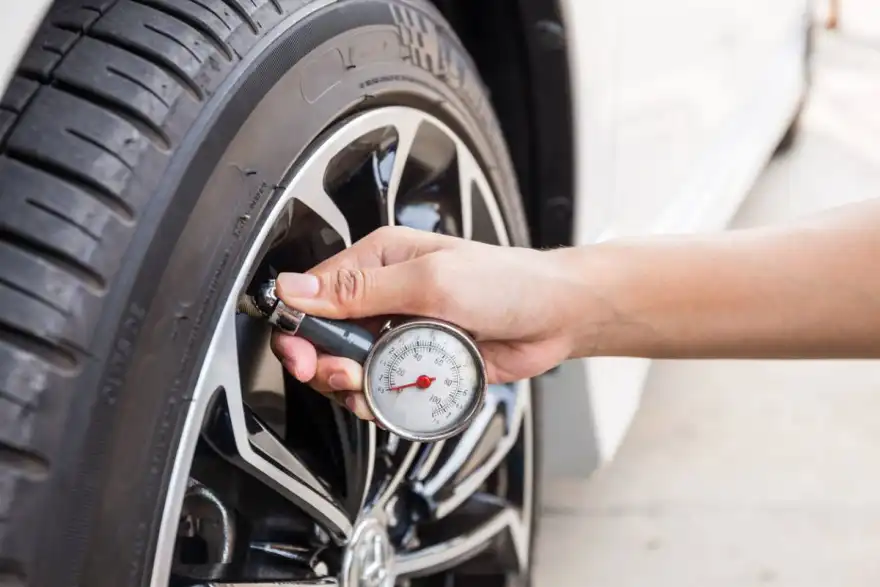
Basic tyre checks
Tyres must be properly inflated, in excellent condition, and not too old for your car to be safe. Quick, simple checks confirm whether everything is in order and are more important than many people recognise. Dangerous tyres have been the cause of countless of collisions.
Tyre pressure
Tyre pressure influences how your vehicle brakes, handles, and rides so check it frequently with a pressure gauge. An under or overinflated tyre can also wear out prematurely. To find the recommended pressure, check your owners manual, look inside your door frame or inside the fuel flap. If all of that fails, try Google. There may be varying recommendations depending if the tyre is at the front of your car, the back, if the car is heavily laden, or if it is light.
Tread depth
A tyre’s tread helps it clear rain, icy slush, and other such things from its path so it can stick to the road beneath. How effectively it works is greatly influenced by the depth of the tread. When the tyre is new, there is plenty of depth so it can clear a lot of debris. As the tyre’s tread wears it clears less debris, so there is less traction. On this basis, it is important to regularly check your tread depth with a digital or manual gauge.
In the UK, the legal minimum tread depth is 1.6mm across the central 75% of a tyre’s width and around its circumference. However, it is better to replace the tyre earlier if money permits.
Rather than a gauge, you can estimate the tread depth via the tyre’s wear markers which are small, black, rectangular bits of rubber. If the tyre is new, the markers sit deep in its tread at the bottom of the grooves. Once the tyre is at – or anything below – the legal limit the markers sit flush with the rest of the tread.
Tyre damage
A damaged tyre is far more likely to fail than a healthy counterpart. Failure could cause a serious collision. Check the tyre for bulges, punctures, and excessive cracking on its sidewall.
Tyre date code
A tyre’s performance can diminish with age even if it has only covered a few miles. Constant exposure to hot and cold weather takes a toll. On this basis, check the date code on the tyre’s sidewall to see when it was produced. Code 51 20, for example. The 51 reveals the week of the year. It is week 51 of 52. The 20 confirms the year. It is 2020. There is no definitive age that a tyre becomes unfit, but evaluate it more frequently as time passes.
Tyre size and specification
When you purchase a tyre, it has to be the right size and specification for your car to be safe. The owner’s manual reveals the correct specification via a code. Simply buy a tyre that has the same code on its sidewall. 215/50 R17 91 V is a common example.
The 215 reveals the tyre’s width in millimetres. The 50 is the height of the sidewall as a percentage of the width. The R proves the tyre has a radial construction and 17 reveals it fits a 17” wheel. 91 is a load rating which is how much weight the tyre can support. Finally, V is the speed rating. See tables below reveal more.
Tyre load ratings
| Code | Load in kg | Code | Load in kg | Code | Load in kg |
| 62 | 265 | 84 | 500 | 106 | 950 |
| 63 | 272 | 85 | 515 | 107 | 975 |
| 64 | 280 | 86 | 530 | 108 | 1000 |
| 65 | 290 | 87 | 545 | 109 | 1030 |
| 66 | 300 | 88 | 560 | 110 | 1060 |
| 67 | 307 | 89 | 580 | 111 | 1090 |
| 68 | 315 | 90 | 600 | 112 | 1120 |
| 69 | 325 | 91 | 615 | 113 | 1150 |
| 70 | 335 | 92 | 630 | 114 | 1180 |
| 71 | 345 | 93 | 650 | 115 | 1215 |
| 72 | 355 | 94 | 670 | 116 | 1250 |
| 73 | 365 | 95 | 690 | 117 | 1285 |
| 74 | 375 | 96 | 710 | 118 | 1320 |
| 75 | 387 | 97 | 730 | 119 | 1360 |
| 76 | 400 | 98 | 750 | 120 | 1400 |
| 77 | 412 | 99 | 775 | 121 | 1450 |
| 78 | 425 | 100 | 800 | 122 | 1500 |
| 79 | 437 | 101 | 825 | 123 | 1550 |
| 80 | 450 | 102 | 850 | 124 | 1600 |
| 81 | 462 | 103 | 875 | 125 | 1650 |
| 82 | 475 | 104 | 900 | 126 | 1700 |
| 83 | 487 | 105 | 925 | 127 |
Tyre speed ratings
| Code | Speed in mph |
| N | 87 |
| P | 93 |
| Q | 99 |
| R | 106 |
| S | 112 |
| T | 118 |
| U | 124 |
| H | 130 |
| V | 149 |
| Z | 150+ |
| W | 168 |
| Y | 186 |




